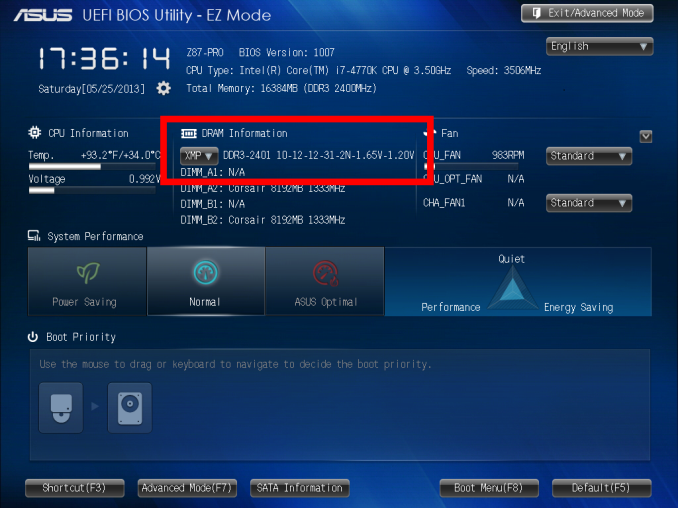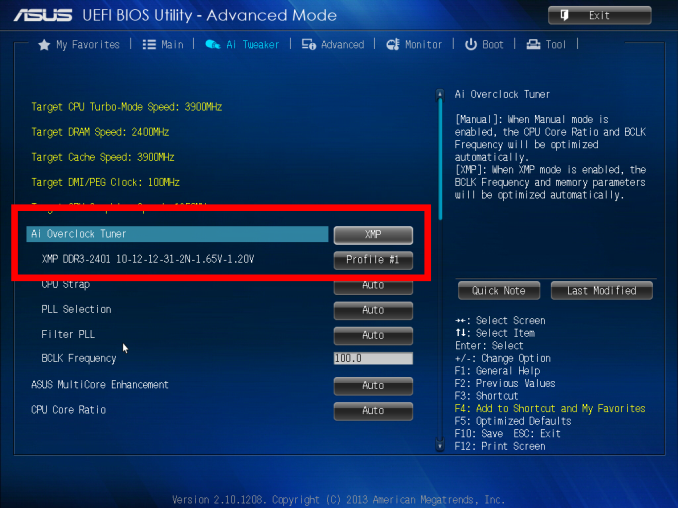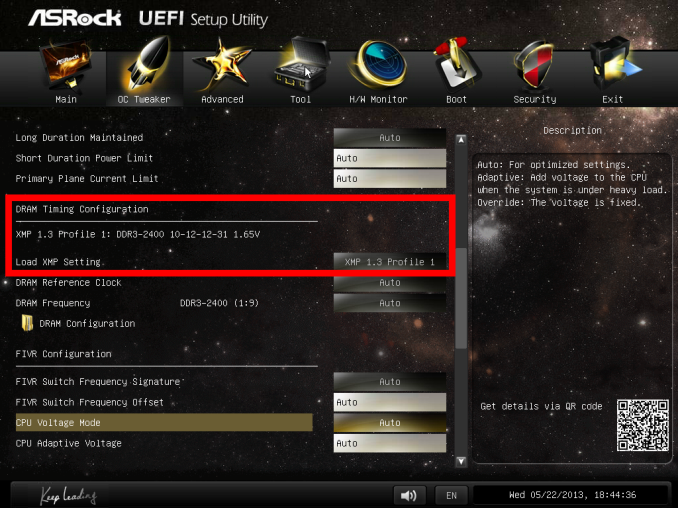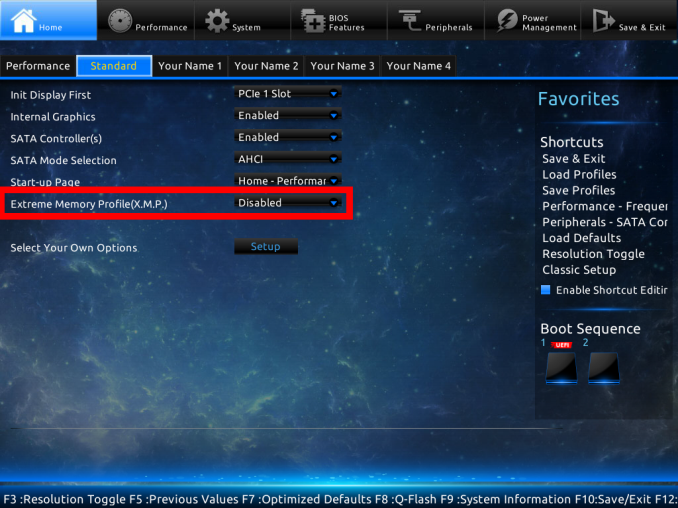Memory Scaling on Haswell CPU, IGP and dGPU: DDR3-1333 to DDR3-3000 Tested with G.Skill
by Ian Cutress on September 26, 2013 4:00 PM ESTEnabling XMP with ASUS, GIGABYTE, ASRock and MSI on Z87
By default, memory should adhere to specifications set by JEDEC (formerly known as the Joint Electron Device Engineering Council). These specifications state what information should be stored in the memory EEPROM, such as manufacturer information, serial number, and other useful information. Part of this are the memory specifications for standard memory speeds, including (for DDR3) 1066 MHz, 1333 MHz and 1600 MHz, which a system will adhere to in the event of other information not being available.
An XMP, or (Intel-developed) Extreme Memory Profile, is an additional set of values stored in the EEPROM which can be detected by SPD in the BIOS. Most DRAM has space for two additional SPD profiles, sometimes referred to as an ‘enthusiast’ and an ‘extreme’ profile; however most consumer oriented modules may only have one XMP profile. The XMP profile is typically the one advertised on the memory kit – if the capability of the memory deviates in any way from specified JEDEC timings, a manufacturer must use an XMP profile.
Thus it is important that the user enables XMP! It is not plug and play!
At big computing events and gaming LANs there are plenty of enthusiasts who boast about buying the best hardware for their system. If you ask what memory they are running, then actually probe the system (by using CPU-Z), I sometimes find that the user, after buying expensive memory, has not enabled XMP! It sounds like a joke story, but this happened several times at my last iSeries LAN in the UK – people boasting about high performance memory, but because they did not enable it in the BIOS, were still running at DDR3-1333 MHz C9.
So enable XMP with your memory!
Here is how:
Step 1: Enter the BIOS
This is typically done by pressing DEL or F2 during POST/startup. Users who have enabled fast booting under Windows 8 will have to use vendor software to enable ‘Go2BIOS’ or a similar feature.
Step 2: Enable XMP
Depending on your motherboard manufacturer, this will be different. I have taken images from the major four motherboard manufacturers to show where the setting is on some of the latest Z87 motherboard models.
On the ASUS Z87-Pro, the setting is on the EZ-Mode screen. Where it says ‘XMP’ in the middle, click on this button and navigate to ‘Profile 1’:
If you do not get an EZ mode (some ROG boards go straight to advanced mode), then the option is under the AI Tweaker tab, in the AI Overclock Tuner option.
For ASRock motherboards, navigate to OC Tweaker and scroll down to the DRAM Timing Configuration. Adjust the ‘Load XMP Setting’ option to Profile 1.
For GIGABYTE motherboards, such as the Z87X-UD3H in the new HD mode, under Home -> Standard is the separate XMP setting, as shown below:
Finally on MSI motherboards, select to the OC option on the left hand side and XMP should be in front of you:
I understand that setting XMP may seem trivial to most of AnandTech’s regular readers, however for completeness (and the lack of XMP being enabled at events it seems) I wanted to include this mini-guide. Of course different BIOS versions on different motherboards may have moved the options around a little – either head to enthusiast forums, or if it is a motherboard I have reviewed, I post up all the screenshots of the BIOS I tested with as a guide.















89 Comments
View All Comments
tynopik - Thursday, September 26, 2013 - link
colors reversed on USB 3.0 Copy Test chart where green is given to the highest (worst) results and red is given to the lowest (best) resultsTegeril - Thursday, September 26, 2013 - link
These are the most colorblind-unfriendly images I've seen to date on this site.Razorbak86 - Friday, September 27, 2013 - link
You tell 'em, bro! Too bad he didn't put actual NUMBERS in the cells, instead of all those non-readable colors. ;)QChronoD - Friday, September 27, 2013 - link
Please redo the IGP gaming benchmarks with playable settings. All you did was waste your time testing at unreasonably high detail and not proven a single thing about whether the extra bandwidth is able to help increase performance.pdjblum - Friday, September 27, 2013 - link
Awesome work. Man, this must have taking forever, even with fast memory. Thanks so much.adityarjun - Friday, September 27, 2013 - link
CAS Latency is given as 6-7-8-9-10-11. What does that mean?http://www.flipkart.com/transcend-jetram-ddr3-8-gb...
Any help on which of these would be better and why?
http://www.flipkart.com/computers/computer-compone...
anton68 - Friday, September 27, 2013 - link
It'd be nice to see how the Iris Pro eDRAM affects compute performance when used as an L4 cache.pjdaily - Saturday, September 28, 2013 - link
I'd like to see this test too.MadAd - Friday, September 27, 2013 - link
Hi Ian, thanks for the review, could you explain the thinking behind using only 1360x768 for the gaming tests, especially for the single card benchmarks? Would stretching the single card with a memory intensive game at a high resolution change the results more towards IGPU fractions?This is more the scenario I would expect gamers to be facing and even if the answer turns out to be no, that in itself would be valuable data to learn.
merikafyeah - Friday, September 27, 2013 - link
Please, please, please incorporate some ramdisk benchmarks for these memory tests. It seems like such a given but no one seems to think of this, which is essentially the only test where you'll see some major differences between speed tiers. Things like gaming don't really result in differences worth your money.I recommend Primo Ramdisk for its rock-solid stability but if you're looking for a free alternative I recommend SoftPerfect RAM Disk, which has been noted to be significantly faster than Primo, but may not be as stable under certain circumstances.